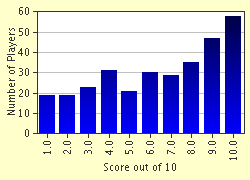Quiz Answer Key and Fun Facts
1. This little bird is most commonly seen at the thistle feeder in the springtime. During breeding, the male is extremely bright yellow with black and white wings and tail, and solid black forehead. Can you name it?
2. The male of this next bird is a gorgeous deep blue with black striped wings and tail. They're a bit shyer than other birds, and we tend to see them only in spring and summer, as they winter in warmer places. Both sexes resemble a sparrow in size, and the female also in color, but with a tinge of blue on tail and shoulders. Can you name this one?
3. Next is one of my favorite tiny southeastern feeder birds. Quick and agile, they are easily told by their black caps and bibs and white faces. They also have a tell-tale call, which is how they are named. Do you know it?
4. This next bird has its own special type of feeder. These birds are often very aggressive toward one another, even the females, and are frequently spotted dive-bombing each other in order to keep possession of the (apparently) prime feeder perch. It is the only one of its type that stays consistently east of the Great Plains. Can you name it?
5. This next bird is another beautiful blue bird, but this time with a rusty throat and breast and white underside. Though we have not actually see these at the feeder (being insect and berry eaters), they are nonetheless often spotted in an open field near the house. When they pair up in the spring, they spend a great deal of time trying to find an ideal home, to the frustration of the birder who has painstakingly bought and mounted several lovely houses specifically for this bird. Do you know this blue beauty with the lovely song?
6. The bird in this question is a commonly seen, bright red bird with a black face and red crested head. The female is duller and browner, but where the male is spotted, the female is not far away. Though quite well-known in the East, it remains a favorite to see. Can you name this one?
7. This next bird is another favorite at the feeder. Quick and perky, it is often seen in the company of chickadees, and is about chickadee-sized. However, it is light gray with a small crested head and tan sides. It winters year-round in the same location. Do you know it?
8. Here's a bird that's a favorite of the southeastern states. Small, brown back, light tan undersides, with a broad white stripe over the eye and a perky little tail, this little bird has a very big song for such a little package. Can you tell which bird it is?
9. This bird is usually only spotted in southeastern states in the spring and fall time, as it makes its migration with the seasons. But the male is easily identified by his black head and back, white underside, and bright reddish bib. The female looks a little like a large fat sparrow, but with a significantly thicker beak. Do you know it?
10. This last bird is an extremely common member of the pigeon and dove family. It loves to feed on the ground below the feeder, picking up small millet grains tossed out by the other birds. It is often told by the "whistling" noise it makes when taking off in flight, and its early morning "crying" is diagnostic. Can you name it?
Source: Author
djsgal
This quiz was reviewed by FunTrivia editor
crisw before going online.
Any errors found in FunTrivia content are routinely corrected through our feedback system.

